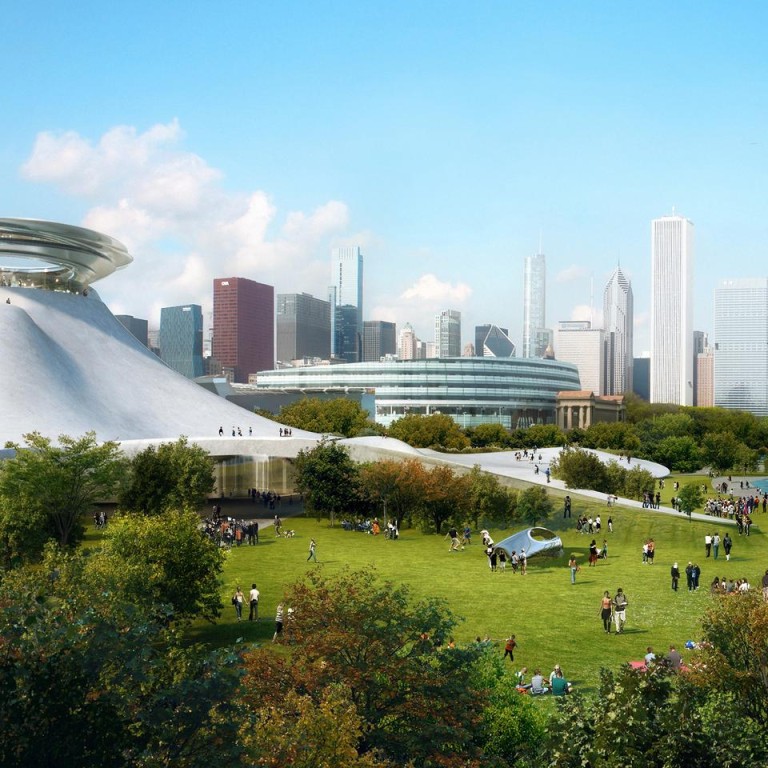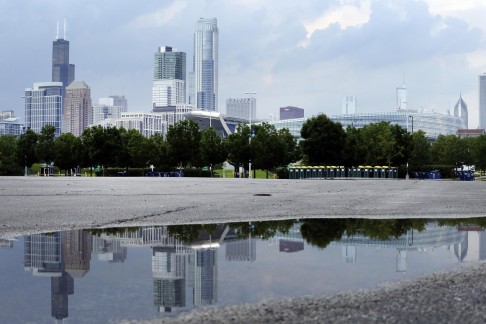
Design for Lucas Museum of Narrative Art has protectionists worried
Futuristic design of Lucas Museum in Chicago has advocacy group worried about encroachment on Lake Michigan shoreline, writes Blair Kamin
If you expect American filmmaker George Lucas to give Chicago a low-slung museum that'll slip quietly into the fiercely contested ground of the city's lakefront, I have news for you: you're wrong.
A conceptual plan recently revealed for the proposed Lucas Museum of Narrative Art sketches a far more ambitious vision from the creator and his architect: a curvaceous, nearly windowless mountain of a building, topped by a glassy observation deck that would resemble a flying saucer.
But open-space advocacy group Friends of the Parks sued the city on Thursday, saying the site is on a lakefront spot that cannot be handed over to a private entity. It says the design is a view-obstructing intrusion on the Lake Michigan shoreline. "It's like this amorphous, land-eating colossus," its president Cassandra Francis says.
But the museum's 39-year-old architect, Ma Yansong of Beijing, says his design will have an impact comparable to that of the city's Millennium Park, a public area once occupied by parking lots and rail yards but now a tourist attraction that has ignited a development boom around it. "Our site deserves something like that," Ma says. "I'm sure that people will find this better than the existing parking lot."
Yet there's plenty of artistic licence in Ma's concept of a mountain rising gracefully from the lakefront landscape. Chicago, after all, is pancake flat and, lacking real mountains, the city has built soaring peaks of steel, glass and stone. Ma's structure is about 34 metres tall.
Whatever one thinks of Ma's design, it represents a radical turnaround from the traditional Spanish revival design Lucas floated last year for a site in San Francisco which was turned down by the city's planners in February.
The seven-level, 400,000-square-foot structure will occupy the southern half of a 6.8-hectare site offered to Lucas by Mayor Rahm Emanuel, who wrested the project from San Francisco.
Emanuel has portrayed the Lucas Museum as the ideal way to complete Chicago's Museum Campus, a cluster of three natural history museums: the Field Museum, the Shedd Aquarium and the Adler Planetarium.


"We want this building to be part of the Museum Campus," Ma says. "We want to create a destination, to really attract a lot of young people to come and explore."
The building will be clad in whitish-grey stone or concrete, a departure from Ma's habit of covering his designs in silvery metal skins. That cladding, to be constructed with the aid of advanced computer modelling, may either enhance the Lucas Museum's relationship to the classically inspired temples of the Museum Campus - or make it a leaden presence.
No price tag is attached to the project, which is expected to be formally submitted to city officials early next year. Lucas has promised to pay for the building and landscaping, although the city may be hit with expenses for related items to ease anticipated traffic congestion.
"We welcome this initial conceptual design so that Chicagoans can begin to explore a new museum and park on our Museum Campus," mayoral spokesman Adam Collins says.
It’s like this amorphous, land-eating colossus
Ma made his presentation last week in a conference room at the Waldorf Astoria Chicago. Joining him were Angelo Garcia, president of Lucas Real Estate Holdings and vice-president of the museum, and Michael Toolis, chief of the Chicago architectural firm VOA Associates, which will be responsible for details such as construction drawings.
Key features of the proposal include a new pedestrian bridge, outdoor plazas and an amphitheatre on the museum's second level, and a significant addition of green space to the Museum Campus - although an estimate of its size has yet to be given. Francis, of Friends of the Parks, says the design creates less parkland than promised and will block views of the lake from Lake Shore Drive.
Inside the museum there's a sky-lit, domed lobby, ringed by galleries for Lucas' collection, which includes paintings by Norman Rockwell and other artists, movie memorabilia including objects, and digital art. Ramps outside the dome lead to four levels of galleries above.

The interior will also include four movie theatres, archives, offices, an education centre, a restaurant on the sixth floor, and an observation deck on the seventh floor. Windows sliced into the museum's facade will offer views of the lakefront and the downtown skyline.
At 400,000 square feet, the museum is about four times the size of the 93,000-square-foot building Lucas planned in San Francisco. That building, with two tall storeys, was about 20 metres tall compared with the Chicago edifice's 34 metres.
For the Beijing-born Ma, founder of the firm MAD Architects, who has won international recognition for museums at home in China and the curvaceous "Marilyn Monroe" residential towers near Toronto, the latest unveiling represents a striking professional turnabout.
In 2000, before he began graduate studies at Yale's architecture school, he was a summer employee at the office of Chicago architect Helmut Jahn. He recalls walking along the lakefront from the Lincoln Park neighbourhood to the site now proposed for the Lucas Museum, taking in fireworks and food festivals. Now he is designing a major building on a choice waterfront site.
"It's not about me," Ma says of his design. "You already have so much great architecture" in Chicago. The idea is "to create a future architecture for Chicago", one, he says, that creates harmony "between the person and the landscape".
The Chicago Plan Commission is among the bodies reviewing the museum's plans. Lakefront protectionists say the museum should be located elsewhere. They cite the 1973 Lakefront Protection Ordinance, which calls for Chicago to protect the Lake Michigan shoreline's open character.
"Ultimately, we don't want to look back at this design and regret a hasty decision to sacrifice our lakefront - Chicago's greatest natural asset," Francis says.
